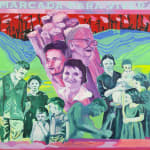-
Obras
Marcela Cantuária
As três idades de Elizabeth Teixeira, 2021acrílica sobre tela
[ccrylic on canvas]150 x 200 x 6 cm
[59 1/8 x 78 3/4 x 2 3/8 in]
10.5 KgCopyright O ArtistaMais imagens
-
(View a larger image of thumbnail 1
)

-
(View a larger image of thumbnail 2
)

-
(View a larger image of thumbnail 3
)

-
(View a larger image of thumbnail 4
)

-
(View a larger image of thumbnail 5
)

-
(View a larger image of thumbnail 6
)

-
(View a larger image of thumbnail 7
)

-
(View a larger image of thumbnail 8
)

-
(View a larger image of thumbnail 9
)

Nascida em 1925 em Sapé, a 50 km da capital paraibana. Aos 16 anos, inicia seu relacionamento com João Pedro Teixeira - negro, operário e pobre. Juntos foram para Jaboatão...Nascida em 1925 em Sapé, a 50 km da capital paraibana.
Aos 16 anos, inicia seu relacionamento com João Pedro Teixeira - negro, operário e pobre. Juntos foram para Jaboatão dos Guararapes (PE), onde ele ajudou a fundar o Sindicato dos Trabalhadores da Construção.
Enfrentando dificuldade para arrumar emprego por conta da sua atividade por direitos trabalhistas, João e Elizabeth voltam a Paraíba e foi lá que o casal liderou a Liga Camponesa do estado, onde também tiveram 11 filhos. Caminhando pela estrada de terra com uma pilha de livros nas mãos para suas crianças, João foi assassinado pelas costas a mando de latifundiários.
Nos estados de Pernambuco e Paraíba a temperatura era quente quando se tratava de resistência a repressão contra a organização camponesa, pois eram locais onde eles estavam mais organizados Por conta disso, Elizabeth enfrentou diversos opositores e foi presa algumas vezes. Em 1964, ela passou a viver na clandestinidade. Foi para o interior do Rio Grande do Norte e adotou o nome falso de Marta Maria da Costa, onde permaneceu escondida por 17 anos, lavando roupa e lecionando.
Em 79 foi anistiada, voltando à Paraíba.
Até hoje, aos 96 anos, se pronuncia sobre o tema: “Enquanto houver a fome e a miséria atingindo a classe trabalhadora, tem que haver luta dos camponeses, dos operários, das mulheres, dos estudantes e de todos aqueles que são oprimidos e explorados”, disse num encontro com o ex-presidente Lula, em 2017.
Elizabeth Teixeira was born in 1925 in Sapé, northeast Brazil.
At age 16, she started a relationship with João Pedro Teixeira, a black, working class and poor man. Together they went to Jaboatão dos Guararapes (PE), where he helped found the Construction Workers Union.
Facing difficulties to find a job due to their activity for labor rights, Joao and Elizabeth return to Paraíba and it was there that the couple led the state's Peasant League, where they also had 11 children. Walking along the dirt road with a pile of books in his hands for their children, João was murdered from behind at the behest of landowners.
In the states of Pernambuco and Paraíba there was a strained atmosphere when it came to resistance and repression against the peasant organization, as there were places where they were more organized. As a result, Elizabeth faced several opponents and was arrested a few times. In 1964, she went underground. She went to the interior of Rio Grande do Norte and adopted the false name of Marta Maria da Costa, where she remained hidden for 17 years, working as a teacher and clothes washer.
In 1979 she received amnesty, moving back to Paraíba.
At the age of 96, she speaks on the theme: “As long as there is hunger and misery affecting the working class, there must be a struggle of peasants, workers, women, students and all those who are oppressed and exploited," from a meeting with former president Lula, in 2017.
Na galeria
Arte como Oferenda⎥Festival Arte dos Povos⎥MAM Rio de Janeiro⎥Rio de Janeiro, Brasil ⎥2022 [03.11 - 06.11]
ArtRio | Marina da Glória, Rio de Janeiro, Brasil | 2022 [14.09-17.09]
ArtRio | Marina da Glória, Rio de Janeiro | [14.09-18.09] | 2022 -
(View a larger image of thumbnail 1
)








